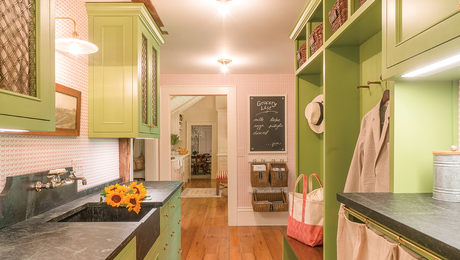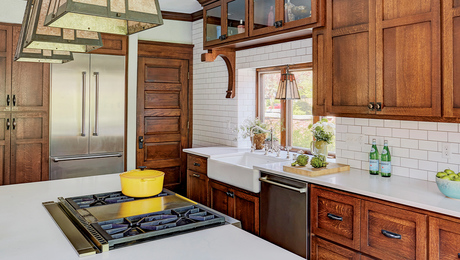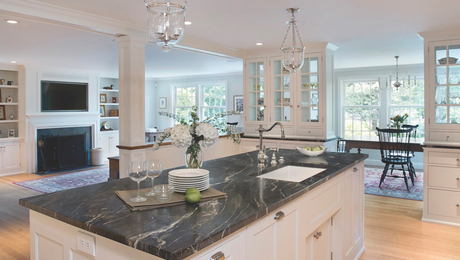A Brilliant, Affordable Kitchen
How a young architect designed and built the kitchen of his dreams for under $10,000.

Synopsis: Architect Reid Highley lived for several years with an inadequate kitchen. When he got engaged, however, he knew it was time for an upgrade. At 180 sq. ft., the kitchen was surprisingly large for an 800-sq.-ft. house, but most of that space was wide open. Highley’s first decision was to place a multifunction island in that empty space. In addition to providing bar-style seating, trash and dog-food storage, and counter space, the island hides a front-loading washer and dryer. Highley also purchased a cooktop, convection oven, range hood, sink, and cabinets from Ikea. He found his best deal, though, in a dumpster: white marble toilet partitions that he cut to size, polished, and installed as countertops. Starting with a budget of $10,000, he transformed the room so creatively and cost-effectively that he ended up spending just over half of that amount.
When I bought my house several years ago, I did so despite the condition of the kitchen. Age and a bad renovation attempt had left their marks. As a young (read: poor) professional, I knew it would be a while before I could renovate.
For several years, I tolerated the room and its deficiencies. I was a bachelor, and I was rarely home long enough to make anything more than a bowl of cereal for dinner. But when I got engaged, I knew that the time for procrastination was over. My soon-to-be wife and I would need a grown-up kitchen.
I figured I could spend about $10,000 on the renovation. With that number in mind, I set out to design a kitchen that an architect could be proud of.
Transforming the dead zone
Although the kitchen was in bad shape, it had one thing going for it: its size. At around 180 sq. ft., it’s larger than you might expect in an 800-sq.-ft. house. Nevertheless, a sizable chunk of this space was empty and had no good use. My first design decision was to fill a portion of this dead zone with a large, multifunction island. Because the house had no laundry facilities, I sized the island so that a front-loading washer and dryer could fit inside. Concealed behind pairs of doors, these appliances are hidden in plain sight. Few of our dinner guests realize that they are dining in the laundry room. In addition to providing a home for the laundry, the island has bar-style seating for breakfast, trash storage, dog food storage, and plenty of counter space for food prep or folding clothes. I also punched a “window” through the wall behind the island to open views straight through the house, creating a more open feel in the room.
The other end of the dead zone became the dining area. To keep the seating footprint compact and to gain storage space, I bought two benches, gave them a custom look by adding some trim, and set them against wainscoting.
Keeping down costs
To keep my budget and timeline intact, I kept the work zone of the kitchen in nearly the same configuration as the original. This eliminated what could easily have turned into costly plumbing and electrical work. I also was creative and resourceful when it came to selecting fixtures, materials, and appliances.
Happily, with a lot of hard work, I pulled off the renovation comfortably under my $10,000 target. Even better, the room doesn’t give the impression that it’s the result of penny-pinching. In these uncertain economic times, I consider it a responsibility to demonstrate that exceptional projects can be realized on less-than-exceptional budgets. In fact, financial limitations seem to spur creativity in a way that unlimited budgets often don’t.
For more photos, drawings, and details, click the View PDF button below:
Fine Homebuilding Recommended Products
Fine Homebuilding receives a commission for items purchased through links on this site, including Amazon Associates and other affiliate advertising programs.

Get Your House Right: Architectural Elements to Use & Avoid

Graphic Guide to Frame Construction

All New Bathroom Ideas that Work

























